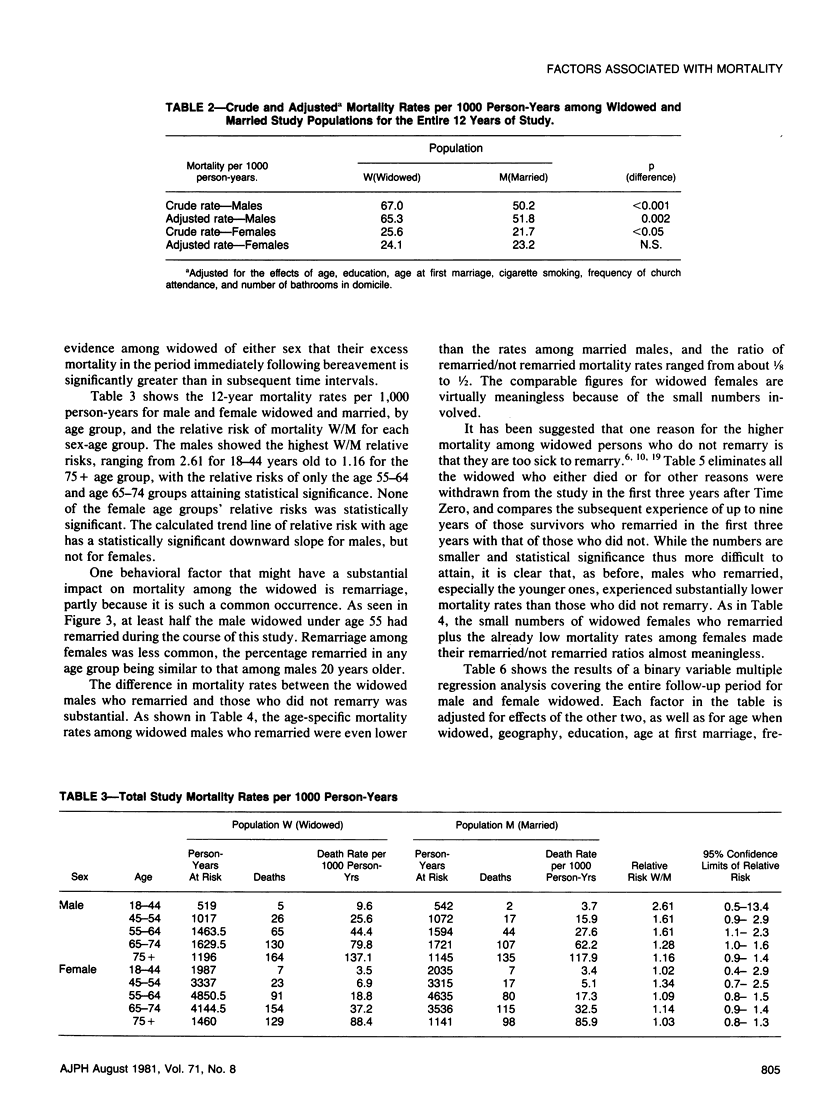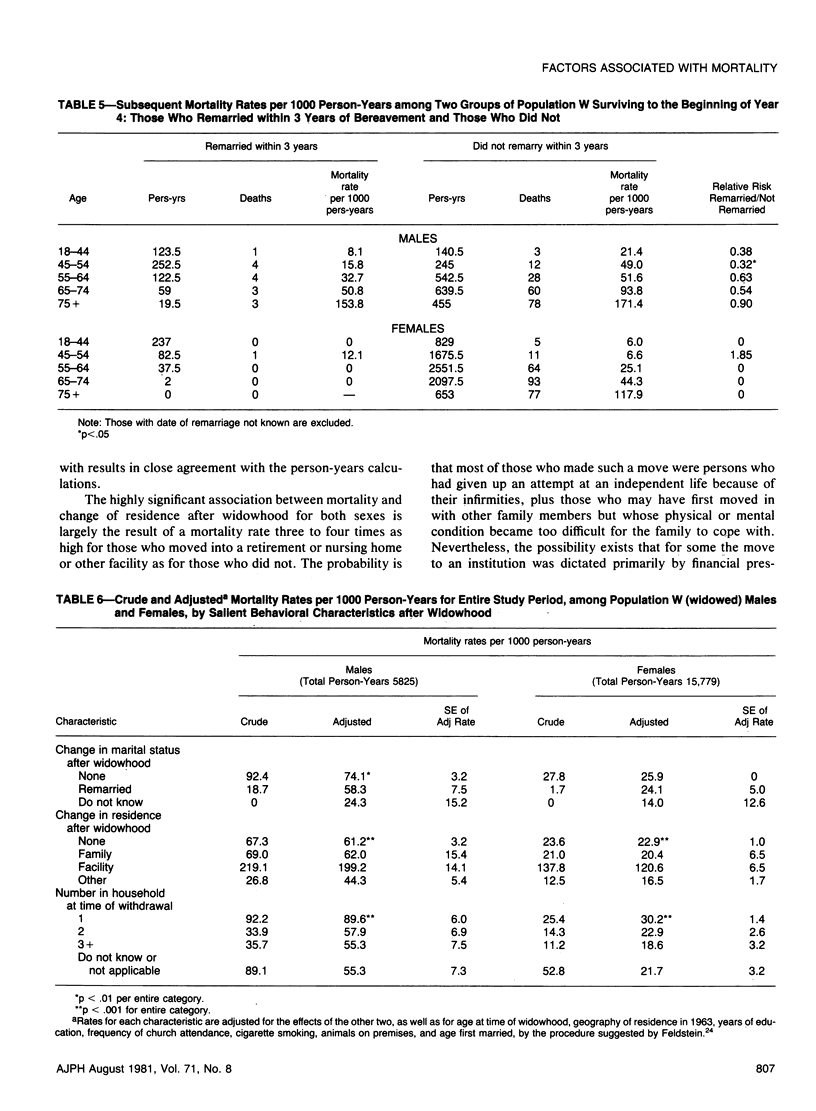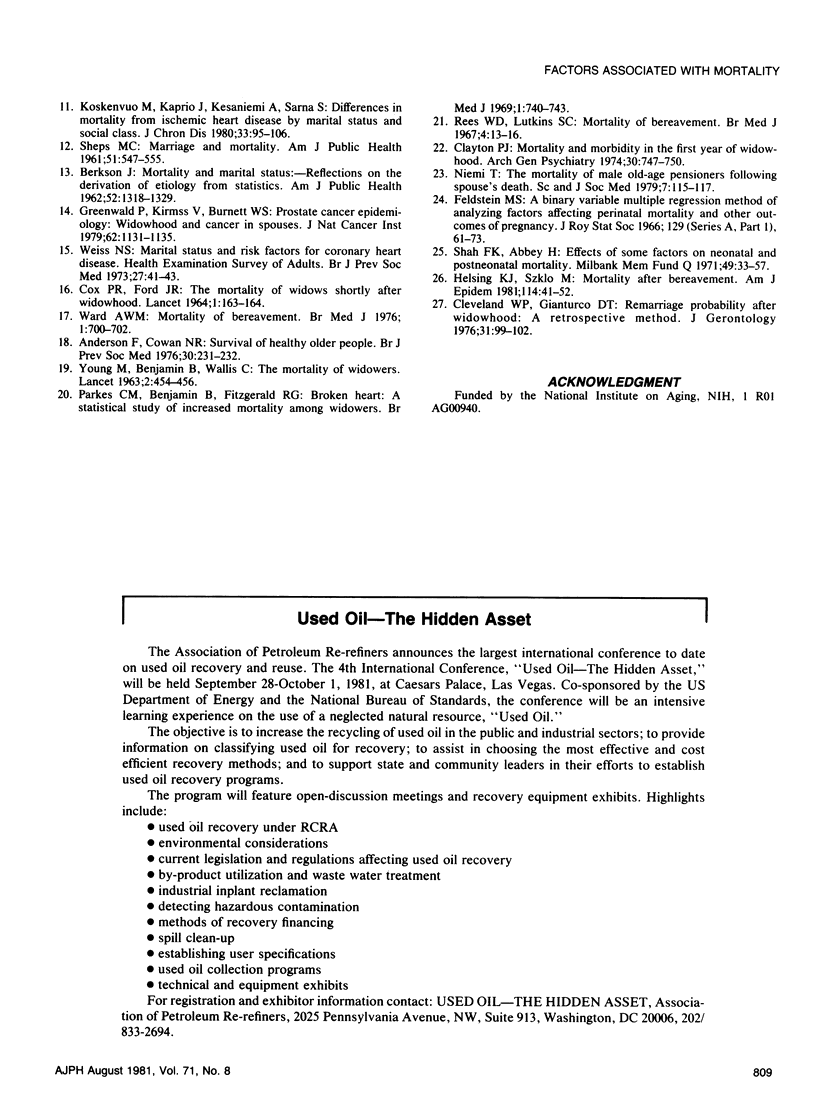Abstract
A non-concurrent prospective study in Washington County, Maryland identified 4,032 (1,204 male, 2,828 female) White persons aged 18 and over who were enumerated in a 1963 non-official census and who became widowed between 1963 and 1974, and an equal number of married persons, each matched to a widowed as to race, sex, year of birth and geography of residence. All were followed to 1975, the date of a second census. Mortality rates based on person-years at risk were about the same for widowed as for married females, but significantly higher for male widowed than male married, even after adjustment for a number of demographic, socioeconomic, and behavioral variables. Mortality rates among widowed males who remarried were very much lower than among those who did not remarry, but no significant difference was observable among widowed females who did nor did not remarry. Multiple regression analysis also showed that, for both sexes and independently of other factors, moving into a nursing home or other chronic care facility was associated with higher mortality than any other residential change or no change, and living alone was associated with higher mortality than living with someone else in the household.
Full text
PDF







Selected References
These references are in PubMed. This may not be the complete list of references from this article.
- Anderson F., Cowan N. R. Survival of healthy older people. Br J Prev Soc Med. 1976 Dec;30(4):231–232. doi: 10.1136/jech.30.4.231. [DOI] [PMC free article] [PubMed] [Google Scholar]
- BERKSON J. Mortality and marital status. Reflections on the derivation of etiology from statistics. Am J Public Health Nations Health. 1962 Aug;52:1318–1329. doi: 10.2105/ajph.52.8.1318. [DOI] [PMC free article] [PubMed] [Google Scholar]
- COX P. R., FORD J. R. THE MORTALITY OF WIDOWS SHORTLY AFTER WIDOWHOOD. Lancet. 1964 Jan 18;1(7325):163–164. doi: 10.1016/s0140-6736(64)92245-7. [DOI] [PubMed] [Google Scholar]
- Clayton P. J. Mortality and morbidity in the first year of widowhood. Arch Gen Psychiatry. 1974 Jun;30(6):747–750. doi: 10.1001/archpsyc.1974.01760120013002. [DOI] [PubMed] [Google Scholar]
- Cleveland W. P., Gianturco D. T. Remarriage probability after widowhood: a retrospective method. J Gerontol. 1976 Jan;31(1):99–103. doi: 10.1093/geronj/31.1.99. [DOI] [PubMed] [Google Scholar]
- Comstock G. W., Tonascia J. A. Education and mortality in Washington County, Maryland. J Health Soc Behav. 1978 Mar;18(1):54–61. [PubMed] [Google Scholar]
- Greenwald P., Kirmss V., Burnett W. S. Prostate cancer epidemiology: widowerhood and cancer in spouses. J Natl Cancer Inst. 1979 May;62(5):1131–1136. [PubMed] [Google Scholar]
- Helsing K. J., Szklo M. Mortality after bereavement. Am J Epidemiol. 1981 Jul;114(1):41–52. doi: 10.1093/oxfordjournals.aje.a113172. [DOI] [PubMed] [Google Scholar]
- Holmes T. H., Rahe R. H. The Social Readjustment Rating Scale. J Psychosom Res. 1967 Aug;11(2):213–218. doi: 10.1016/0022-3999(67)90010-4. [DOI] [PubMed] [Google Scholar]
- Horwitz O., Weber J. Aegteskabelig stilling og dødelighed. I. Hele Danmark. Ugeskr Laeger. 1973 May 28;135(22):1089–1095. [PubMed] [Google Scholar]
- KRAUS A. S., LILIENFELD A. M. Some epidemiologic aspects of the high mortality rate in the young widowed group. J Chronic Dis. 1959 Sep;10:207–217. doi: 10.1016/0021-9681(59)90003-7. [DOI] [PubMed] [Google Scholar]
- Koskenvuo M., Kaprio J., Kesäniemi A., Sarna S. Differences in mortality from ischemic heart disease by marital status and social class. J Chronic Dis. 1980;33(2):95–106. doi: 10.1016/0021-9681(80)90033-8. [DOI] [PubMed] [Google Scholar]
- Niemi T. The mortality of male old-age pensioners following spouse's death. Scand J Soc Med. 1979;7(3):115–117. doi: 10.1177/140349487900700303. [DOI] [PubMed] [Google Scholar]
- Parkes C. M., Benjamin B., Fitzgerald R. G. Broken heart: a statistical study of increased mortality among widowers. Br Med J. 1969 Mar 22;1(5646):740–743. doi: 10.1136/bmj.1.5646.740. [DOI] [PMC free article] [PubMed] [Google Scholar]
- Rees W. D., Lutkins S. G. Mortality of bereavement. Br Med J. 1967 Oct 7;4(5570):13–16. doi: 10.1136/bmj.4.5570.13. [DOI] [PMC free article] [PubMed] [Google Scholar]
- Shah F. K., Abbey H. Effects of some factors on neonatal and postneonatal mortality. Analysis by a binary variable multiple regression method. Milbank Mem Fund Q. 1971 Jan;49(1):33–57. [PubMed] [Google Scholar]
- Sheps M. C. Marriage and Mortality. Am J Public Health Nations Health. 1961 Apr;51(4):547–555. doi: 10.2105/ajph.51.4.547. [DOI] [PMC free article] [PubMed] [Google Scholar]
- Ward A. W. Mortality of bereavement. Br Med J. 1976 Mar 20;1(6011):700–702. doi: 10.1136/bmj.1.6011.700. [DOI] [PMC free article] [PubMed] [Google Scholar]
- Weiss N. S. Marital status and risk factors for coronary heart disease. The United States health examination survey of adults. Br J Prev Soc Med. 1973 Feb;27(1):41–43. doi: 10.1136/jech.27.1.41. [DOI] [PMC free article] [PubMed] [Google Scholar]
- YOUNG M., BENJAMIN B., WALLIS C. THE MORTALITY OF WIDOWERS. Lancet. 1963 Aug 31;2(7305):454–456. doi: 10.1016/s0140-6736(63)92193-7. [DOI] [PubMed] [Google Scholar]


